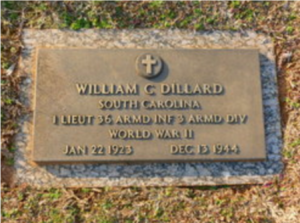Scroll of Honor – Bill Dillard
Winter War
Written by: Kelly Durham
When we think about winter combat in World War II, most of us recall the Battle of the Bulge and  the heroic stand of American forces in surrounded Bastogne. But before that action, American and Allied forces were already locked in a miserable battle against the Germans, the terrain and the weather in the Hürtgen Forest. Approximately fifty miles square, the Hürtgen Forest lies just east of the Belgian-German border and beginning in September 1944 was the site of the American Army’s longest-running battle on German territory. Bill Dillard of Six Mile was in the thick of the fight.
the heroic stand of American forces in surrounded Bastogne. But before that action, American and Allied forces were already locked in a miserable battle against the Germans, the terrain and the weather in the Hürtgen Forest. Approximately fifty miles square, the Hürtgen Forest lies just east of the Belgian-German border and beginning in September 1944 was the site of the American Army’s longest-running battle on German territory. Bill Dillard of Six Mile was in the thick of the fight.
William C. Dillard had enrolled at Clemson as a pre-med major. Following his graduation in May 1943, instead of proceeding to medical school, Dillard, like the rest of his classmates, was ordered to active duty. After completing Officer Candidate School at Fort Benning, Georgia that December, Dillard was commissioned as a second lieutenant. By August of the following year, Dillard, now married, shipped overseas. He was assigned to Company B of the 36th Armored Infantry Regiment, 3rd Armored Division. The 3rd Armored Division had led First Army’s breakout from the hedgerows of Normandy, had crossed the Seine River in late August and on September 12 crossed the border into Germany. There, it came face-to-face with the fixed fortifications of the Siegfried Line—and its very determined German defenders.
The Hürtgen Forest was a rugged, heavily forested area crossed by poor, winding roads and favorable for the defense. The Germans made good use of the natural cover and concealment provided by the forest and utilized pillboxes and other fortifications to hold off the advancing Americans. In addition, rainy, then snowy weather helped to minimize the Allies great airpower advantage.
On December 12, while attacking near Stolberg, Germany, Dillard’s company was hit by  “severe artillery, mortar and small arms fire.” An artillery smoke screen further hindered the unit’s movement. According to Dillard’s Bronze Star citation, “With total disregard for his own personal safety, in the face of heavy enemy fire, Lt. Dillard continuously exposed himself and made his way from squad to squad, personally directing his men to covered positions and giving them encouragement which minimized the amount of confusion.” Dillard was wounded during the attack and evacuated to a field hospital where he died the following day. He was twenty-one years old.
“severe artillery, mortar and small arms fire.” An artillery smoke screen further hindered the unit’s movement. According to Dillard’s Bronze Star citation, “With total disregard for his own personal safety, in the face of heavy enemy fire, Lt. Dillard continuously exposed himself and made his way from squad to squad, personally directing his men to covered positions and giving them encouragement which minimized the amount of confusion.” Dillard was wounded during the attack and evacuated to a field hospital where he died the following day. He was twenty-one years old.
Dillard was survived by his wife Wilma, his parents Mr. and Mrs. T. L. Dillard and his sister Eloise, then a student at Furman. In addition to the Bronze Star, Dillard was awarded the Purple Heart and the Combat Infantryman’s Badge. Dillard’s son Billy was born on January 18, 1945 and would follow in his father’s footsteps, graduating from Clemson University in 1965.
Three days after Dillard’s death, the Germans launched their last offensive which soon became known as the Battle of the Bulge. That effectively ended the Hürtgen campaign as the Allies shifted every available unit north to blunt the German attack.
Historians consider the Battle of the Hürtgen Forest to be a rare German victory that  late in the war as the Americans suffered nearly 140,000 casualties from weather, accidents, and enemy fire without seizing strategic objectives.
late in the war as the Americans suffered nearly 140,000 casualties from weather, accidents, and enemy fire without seizing strategic objectives.
For more information about William C. Dillard see:
https://soh.alumni.clemson.edu/scroll/william-clayton-dillard/
For additional information about Clemson University’s Scroll of Honor visit:
